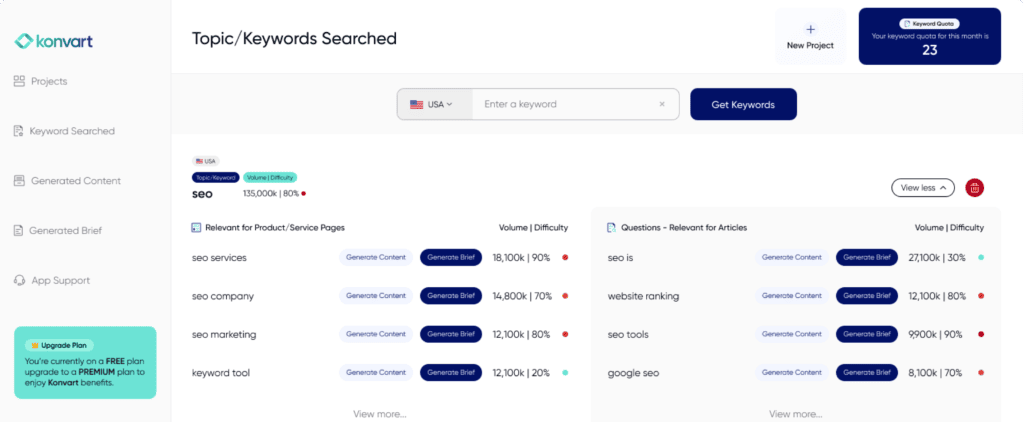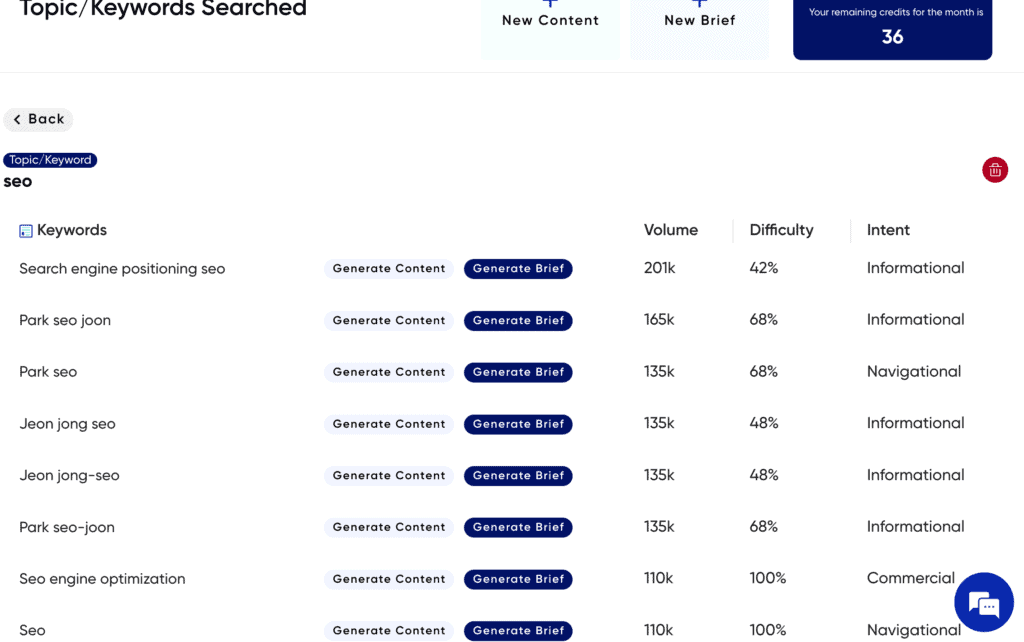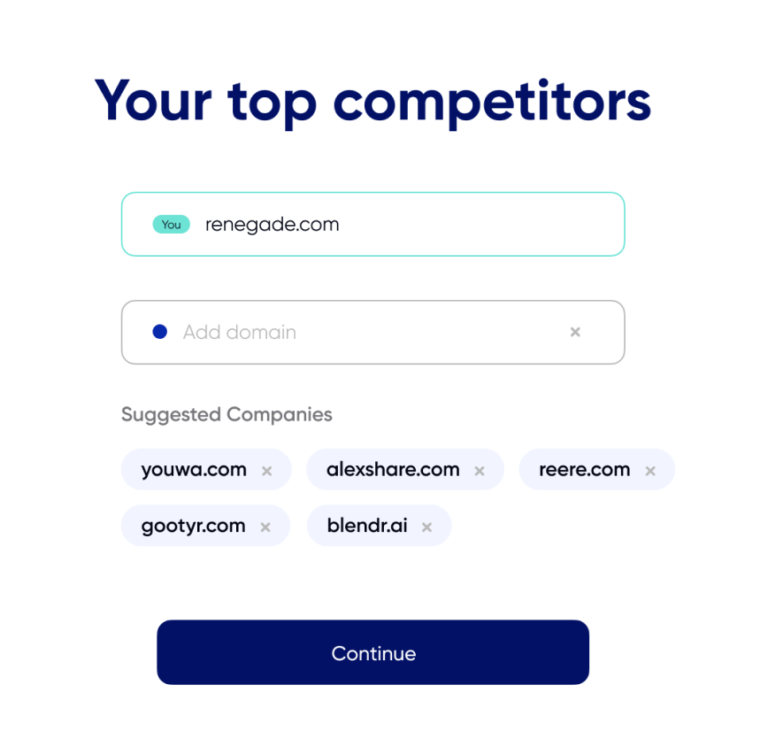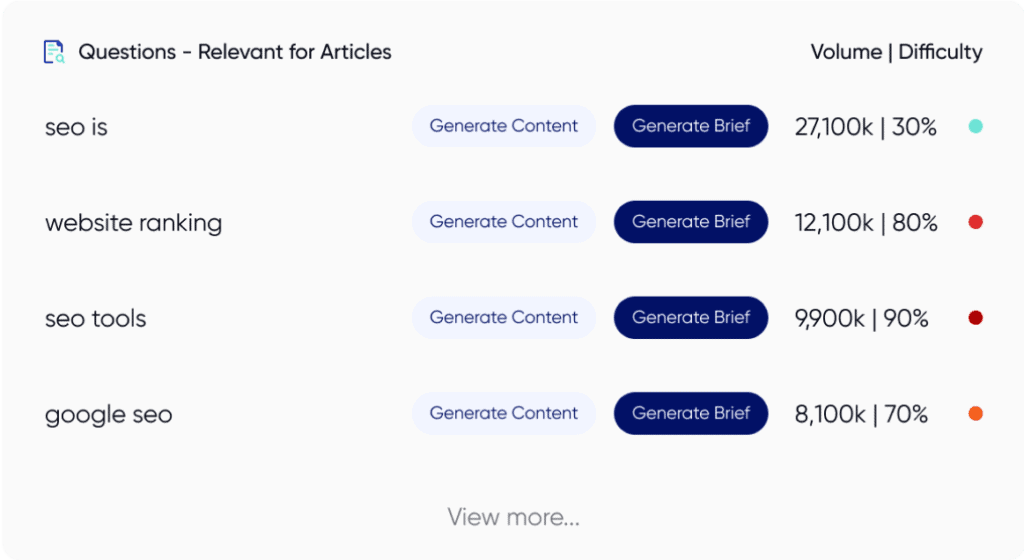With about 4 billion people using Google every month and 82% of internet users searching online using search engines, SEO is far from dead, so you must analyze keywords properly if you want your online visibility and traffic to increase.
Keyword analysis involves evaluating search volumes and difficulties, which helps identify how often certain words are searched and how challenging it is to rank for those terms. Additionally, competitor keyword analysis, including assessing keyword gaps, allows you to pinpoint opportunities where your competitors might be outperforming you and areas where you can gain a competitive edge.
Why is Keyword Analysis Important?
Keyword analysis helps decipher the intent behind potential customers’ searches. With that understanding, you can tailor your content to meet their needs more effectively. For instance, a high search volume for “how to bake a chocolate cake” indicates a significant interest in baking guides rather than just recipes.
Search engines like Google rank websites based on relevance and authority. Keyword analysis is critical because it informs you which terms are most searched and which ones to target to appear more prominently in search results. A well-optimized website with strategically placed keywords has a better chance of ranking higher. This visibility is key in attracting more clicks; studies show that the first five organic results account for 67.6% of all the clicks on Google.
In addition, through competitor keyword analysis, businesses gain insights into the terms their competitors are targeting. This knowledge allows them to identify gaps in their own keyword strategies and discover new opportunities. For example, if competitors are not ranking well for certain keywords with high search volumes, you can capitalize on this by optimizing these keywords in your own content.
You also must consider your resources. Effective keyword analysis ensures that resources are not wasted on low-value or highly competitive keywords that offer little return on investment. By focusing on keywords with reasonable competition and good search volumes, businesses can allocate their marketing budgets more efficiently, focusing efforts where they are most likely to yield results.
Keywords serve as a cornerstone for content strategy development. They help dictate the topics that will be most interesting and valuable to your target audience. A robust keyword analysis provides a roadmap for creating content that attracts and retains an audience.
Lastly, Keyword trends can shift due to changes in consumer behavior, seasonality, or new market entrants. Regular keyword analysis helps you stay updated with these trends, allowing your content strategy to remain relevant and effective over time.
Types of Keywords
Keywords can be broadly categorized into three main types: short-tail, long-tail, and branded. Each type plays a unique role in search engine optimization (SEO) and has benefits and challenges.
Short-Tail Keywords
Short-tail keywords, often called head terms, are broad and consist of one or two words. An example might be “shoes” or “marketing software.” These keywords are highly competitive due to their high search volumes. Short-tail keywords often drive large amounts of traffic, but converting that traffic into leads or sales can be challenging because of the generic nature of the search. When someone searches using a short-tail keyword, they might just be beginning their research and not yet ready to make a purchase.
Long-Tail Keywords
Long-tail keywords are more specific and usually longer, often containing three or more words. Examples include “women’s running shoes on sale” or “best software for email marketing beginners.” These keywords are less competitive and typically have lower search volumes. However, they tend to attract more qualified traffic with higher conversion rates. Long-tail keywords account for 70% of all web searches. The specificity of long-tail keywords means that users searching these terms are usually further along in the buying process and closer to making a purchase decision.
Branded Keywords
Branded keywords include the name of a company or a specific product, such as “Nike running shoes” or “Mailchimp email templates.” These keywords are crucial for businesses as they drive traffic from users already familiar with the brand or those interested in specific products offered by the brand. Competing for branded keywords can be less challenging if the brand is unique; however, competition can be intense if it shares its name with other more established brands.
How to Do Keyword Analysis in SEO
This process involves several steps that help identify the best keywords to target based on factors like search volume and difficulty and competitor keyword analysis.
Step 1: Identify Your Keywords
Begin by brainstorming a list of potential keywords that relate to your content, products, or services. Aim for a mix of both broad and specific terms. For instance, if you sell handmade soaps, your list might include “handmade soaps,” “organic bath products,” and “natural skincare.” These are typically called seed phrases.
Step 2: Use Keyword Research Tools
Once you have your initial list, use Konvart’s keyword research tool. These platforms provide detailed insights about each keyword, including monthly search volumes, keyword difficulty (KD), and the competitive landscape. Search volume indicates how often a keyword is searched per month, while keyword difficulty shows how hard it would be to rank for that keyword.

Step 3: Analyze Search Volume and Difficulty
Focus on finding keywords that have a reasonable search volume but lower competition.
Search volume indicates how many times a keyword is searched per month, which helps gauge interest levels. High search volumes suggest popular keywords, but these often come with high competition. On the other hand, low-competition keywords might be easier to rank for but won’t generate as much traffic. A balanced approach usually works best.
Tools like Konvart offer insights into these metrics, allowing you to balance between high-interest keywords and those for which you have a realistic chance of ranking. For example, while “packaging” may have a high search volume, “custom eco-friendly packaging” might present a better balance of interest and attainability.
Step 4: Check the Search Intent
Keywords can be classified based on the intent behind the searches, which typically falls into four categories: informational, navigational, transactional, and commercial investigation. By analyzing the intent, you can tailor your content to meet the specific needs or interests of searchers. For instance, keywords with transactional intent like “buy eco-friendly packaging” indicate a readiness to purchase, guiding how you might structure content or select keywords that lead directly to sales.
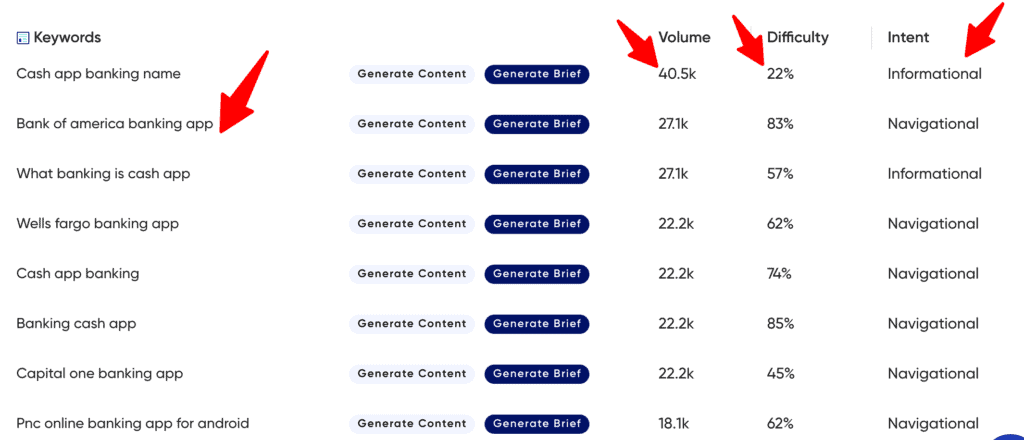
Step 5: Check Out the Competition
Understanding what keywords your competitors are ranking for can provide valuable insights. Tools like Ahrefs’ Competitor Keyword Gap feature allow you to compare your site against others in your niche to see what keywords they are ranking for that you are not. This analysis can help you discover untapped opportunities or areas where you need to improve your content.
Step 6: Examine Related Search Queries
At the bottom of Google’s search results page, you’ll find a section titled “Searches related to [your search term]”. This area provides a list of queries that users also searched for. These suggestions can be a goldmine for discovering new keyword ideas closely related to your original search.
Step 7: Create Keyword Lists
Instead of focusing solely on standalone keywords, consider related groups of terms and topics. For instance, if your main keyword is “organic gardening,” related terms could include “composting techniques,” “best organic fertilizers,” and “seasonal planting guides.”
Once you have a broad list of potential keywords, the next step is to categorize them based on intent and relevance. Grouping keywords can be done in several ways:
- By topic (e.g., digital marketing, SEO tools)
- By intent (informational, transactional, navigational)
- By complexity (head terms vs. long-tail keywords)
This organization aids in understanding which keywords will be most effective for different types of content and user intents.
Step 8: Prioritize Your Keywords
After gathering all the necessary data, prioritize your keywords based on relevance, search volume, difficulty score, and strategic importance to your business. Prioritization helps focus your SEO efforts more efficiently.
Step 9: Continuous Monitoring and Analysis
Keyword trends can change over time due to new market entries, seasonal variations in search behavior, or evolving user interests. Regularly monitoring your chosen keywords and their performance metrics allows you to adapt your strategy as needed.
Reviewing the search terms that lead visitors to your website can offer clues about new keywords to target. Google Analytics provides a wealth of data on how users find your site and the search queries they use. Identifying patterns in this data can help refine your keyword strategy.
Choosing the Right Keywords for Your Business
Here are several strategies to guide you in choosing the most effective keywords.
1. Understanding Your Audience
The first step is to deeply understand who your customers are and what they might be searching for. This involves creating detailed buyer personas that reflect their interests, needs, and typical search behavior. Tools like Google Analytics can provide insights into the demographics and interests of your current website visitors, which can be a valuable starting point.
2. Keyword Relevance and Intent
It is crucial to consider not just the popularity of a keyword but its relevance to your products or services. If users are looking to buy a product, writing a product comparison article makes no sense.
Also, for relevance, choose keywords that are closely aligned with the subject matter of your website or specific page. These should include terms that your target audience is likely to use when searching for information, products, or services similar to what you offer.
Additionally, understanding the intent behind keywords—whether users are looking to buy something, find information, or locate a business—can help tailor your content to meet those needs effectively.
3. Check That You Can Compete
If your website is new or you haven’t done much SEO in the past, it is likely going to be difficult to compete against well-established competitors especially in a competitive space. For websites like this, focusing on long-tail keywords—those that are more specific and usually longer than more commonly searched keywords—can be highly beneficial. For example, instead of targeting “fitness,” opt for “home fitness tips for beginners.” Although these keywords typically have lower search volumes, they often attract more qualified traffic and have less competition. They are also better at meeting the specific needs of users, which can lead to higher conversion rates.
4. Consider Your Location
Local SEO should be part of your keyword strategy if your business has a physical location or serves a specific geographic area. Including location-specific terms can help attract local traffic and cater to users searching for nearby solutions.
Analyze the SERP for a Given Keyword
After doing the initial keyword research and analysis and having chosen some keywords, you need to study the front lines of SEO battlegrounds before creating content for SEO. This analysis reveals what kind of content ranks well and the diversity of content types that appear. In a lot of ways, this is SERP analysis though only for keyword analysis.
Begin by entering your keyword into the search engine and studying the layout of the results page. Notice if there are featured snippets, local packs, knowledge graphs, or video carousels. Each feature provides insight into what Google considers most relevant for that query. For instance, a featured snippet might indicate a high demand for quick, authoritative answers, while a video carousel could suggest that users prefer visual content for that topic.
Here’s a featured snippet:

Now that you have done that, visit the top-ranking pages. Examine their content structure, use of images, and overall user engagement (like comments or social shares if visible). Analyzing these can give you clues about what makes content successful for this keyword. Check if the content is more informational or transactional. This distinction will help you tailor your content to meet user intent effectively.
Look at the commonalities between different top-ranking articles. Do they frequently use certain terms or cover specific subtopics? Tools like the Konvart brief generator can help automate this process by showing you related phrases, headings, and themes used in top articles.
SERP Features and Keyword Analysis
One of the most insightful practices when conducting keyword analysis is previewing SERP (Search Engine Results Page) features for each keyword. This approach helps in identifying various features that could potentially increase visibility on a search page.
What are SERP Features?
SERP features are special formats through which Google presents information to users. These can include featured snippets, local packs, knowledge graphs, and more. Each feature has a unique influence on user behavior and click-through rates. For example, a keyword triggering a featured snippet might mean that users get their answers directly on the search results page, which could reduce the likelihood of them clicking through to a website.
Statistics show that SERP features can significantly impact traffic. For instance, keywords that trigger a featured snippet can see up to a 30% increase in click-through rates compared to standard search listings.
Analyzing Competitor Presence in SERP Features
It’s beneficial to analyze whether and how competitors appear in these SERP features. If competitors frequently appear in featured snippets for relevant keywords, it indicates the effectiveness of their content’s structure and informativeness. In this case, you would need a better answer to the questions in the SERP.
Several SEO tools offer capabilities to preview which SERP features are triggered by specific keywords. Utilizing these tools allows marketers to tailor their SEO strategies more precisely and align them with the opportunities presented by each keyword’s SERP landscape.
Put Your Keywords to Work
After conducting a thorough keyword analysis and identifying the most relevant terms, the next step is to integrate these keywords effectively into your content.
Effective Keyword Placement
Keywords should be incorporated naturally into titles, headers, subheaders, meta descriptions, and the body of your content. The title of your page or blog post is particularly critical because it directly influences click-through rates from search results. A compelling title with a well-placed keyword can significantly improve visibility.
Content Optimization
Within the body of your article or webpage, it’s important to use keywords contextually. They should fit seamlessly into the text, enhancing the reader’s understanding rather than detracting from it. The first 100 words are particularly important for including your primary keyword, as search engines weigh words found early in the content more heavily.
Avoid Keyword Stuffing
While keywords are indispensable for SEO, overusing them can penalize your site. Search engines like Google prefer content that helps users by providing value and relevance. If a page reads unnaturally because of excessive keyword use, it could be flagged as spammy, which would harm its ranking.
Keyword Synonyms and Variants
Using synonyms and variants of your keywords can help avoid redundancy and enhance readability while also catering to a broader range of search queries. Also, pay attention to recurring words or themes in the top results and consider how you might incorporate similar elements into your content.
Can You Use AI for Keyword Research?
Not exactly. Although AI like GPT can provide related words to a keyword, they cannot tell you the search volumes or keyword difficulties of those keywords. You need an SEO keyword research tool like Konvart to provide that data. Nevertheless, AI can be relevant for:
- Analyzing search volume and difficulty to help you prioritize keywords that are worth targeting.
- Scanning and evaluating the content of competitors to extract the keywords and themes they cover.
You can learn more about how AI can help with SEO here and see some AI SEO tools here.
What Makes the Best Keyword Research Tool?
The ideal tool should offer a comprehensive suite of functionalities that cater to both beginners and seasoned SEO professionals.
- Accuracy of Data: A reliable tool pulls its data from clickstream and other search sources and uses sophisticated algorithms to estimate search metrics closely aligned with Google’s own tools. Accurate data helps in making informed decisions about which keywords are worth targeting.
- Depth of Keyword Data: Beyond just search volumes and competition levels, the best tools provide insights into keyword trends, seasonality, low-hanging fruits, and related search queries. This depth allows users to explore various dimensions of keyword performance and discover untapped opportunities.
- User Interface and Ease of Use: The best keyword research tools have intuitive interfaces that simplify the process of searching for and analyzing keywords. Clear tutorials, support resources, and a logical layout are important to help users learn quickly and use the tool effectively.
- Integration Capabilities: A tool that integrates well with other SEO and marketing software (like content management systems and analytics tools) can streamline workflows and enhance data analysis capabilities. Integration helps in aligning keyword research with broader marketing activities for more cohesive strategy planning.
- Cost-Effectiveness: While the most expensive tool isn’t always the best, it’s important to consider what features you are getting for your investment. Tools that offer tiered pricing plans can accommodate the varying needs of different users, from freelancers to large enterprises, ensuring you pay only for what you truly need.
- Regular Updates and Support: A top-notch tool not only updates its features regularly to adapt to these changes but also provides robust customer support to assist users with any issues they might encounter.
The Best Free Keyword Research Tools at a Glance
Here’s a quick overview of the best free keyword research tools:
- Konvart: Konvart provides search volume, keyword difficulty, related keywords, and search intent data to help SEO professionals make decisions and start creating content for their websites. It includes a free trial to help users get the data they need without making a commitment.
- Google Keyword Planner: This tool is a classic choice for beginners due to its direct integration with Google Ads. It offers insights into search volumes, competition levels, and the potential performance of keywords. Users can also see historical data trends which can be helpful in identifying seasonal variations in keyword popularity.
- Ubersuggest: Developed by Neil Patel, this tool provides keyword suggestions, search volume data, competition, and even content ideas. Ubersuggest has a user-friendly interface and the ability to filter results based on location and language, making it ideal for localized SEO strategies.
- AnswerThePublic: By entering a keyword, users receive questions, prepositions, comparisons, alphabetical listings, and related searches. This data visualization helps uncover long-tail keywords and real users’ questions. It’s particularly useful for content creators looking to address specific queries.
Each of these tools has unique features that cater to different aspects of keyword research. While Google Keyword Planner is great for integrating with paid search campaigns, Konvart and Moz provide more comprehensive data that aids in organic search optimization. Lastly, AnswerThePublic is unmatched in generating question-based keywords which are essential for voice search optimization.
The Best Free Keyword Research Platform for a Broad Suite of SEO Tools
When considering the best free keyword research platform offering a comprehensive suite of SEO tools, Konvart stands out for its user-friendly interface and extensive features catering to beginners and seasoned professionals. Konvart provides a robust set of functionalities, including search volume analysis, keyword difficulty scoring, and competitor keyword insights from SERP analysis – all essential components for effective keyword analysis.
Konvart allows users to see the monthly search volume, competition level, and even search intent for various keywords. This helps identify how often certain terms are searched and how difficult it would be to rank for them.
The platform’s intuitive design simplifies data interpretation, making it ideal for SEO beginners who might be overwhelmed by more complex software. Moreover, Konvart also provides actionable SEO tips based on the analyzed data in the form of a brief, if users want, which can guide new users in optimizing their websites more effectively.
Sign up for Konvart today and get the data you need.



